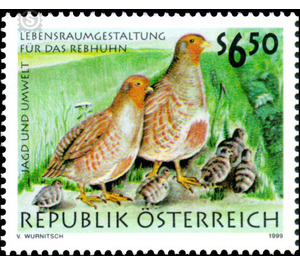Hunting and environment - Austria / II. Republic of Austria 1999 - 6.50 Shilling
Theme: Animals
| Country | Austria / II. Republic of Austria |
| Issue Date | 1999 |
| Face Value | 6.50 |
| Printing Type | Photogravure |
| Stamp Type | Commemorative |
| Item Type | Stamp |
| Chronological Issue Number | 1624 |
| Chronological Chapter | OOS-OE2 |
| SID | 789107 |
| In 59 Wishlists | |
Originally inhabitants of dry grass and bush steppes, the partridge found suitable living conditions in Central Europe through the emergence of large-scale field landscapes. Its largest settlement density in the lowlands reached it here at the time of the Dreifelderwirtschaft. At that time, the chicken bird could still be described as a character species of the field corridor and as a typical cultural successor. With the intensification of field crops in recent decades and the associated emergence of large-scale monocultures, the partridge today hardly any more diverse habitat structures and therefore is represented in many places only in low density or even completely disappeared. Precisely because of this it finds great interest among nature lovers. In view of the low population densities, the hunting of the partridge is only to be represented in those areas where near-natural landscape elements - or habitats created by targeted conservation measures - have corresponding survival rates until autumn and no high winter losses are to be feared. Even with a relatively good partridge stock in the fall, however, only a small percentage should be used for hunting purposes. Where this is no longer possible in the longer term, the hunt in its own responsibility is encouraged to use all opportunities for habitat improvements. Corresponding contacts to farmers, the landscapers of the open field, are inevitable.


